We almost missed out the return to Mount Cook, thinking that we saw the tallest mountain from the west coast when we were at the Fox/Franz Josef glaciers, and what’s the point of seeing it from the other side? It’s a good job we did come back, the view from the east is most definitely the better side.
The drive up passed by the turquoise blue glacial lakes which contrasted nicely with the autumnal orange trees. There were a few wisps of cloud hiding the peaks of the Mount Cook range as we drove up the huge glacial valley to the base of Mount Cook. It’s hard to imagine a glacier so large that it could fill the width and height of the valley, nevermind stretch more than 50km back to the mountains. Rounding the final bend we were treated to the face of a mountain with four glaciers clinging to the almost vertical rocks. It certainly is good to be back in glacier country again, although first call was the visitor centre to get more woolly clothing and have some hot chocolate!
The DoC campsite was literally walking distance to the Mueller Glacier, the second largest in New Zealand. (as I found out by accident after going for a short stroll, not something you expect!) So, unsurprisingly it was fairly cold that night, and as it’s the DoC, there’s no electricity to be leaving the fan heater on all night to keep warm!
Month: April 2008
Dunedin
Dunedin is named after Edinburgh, or more accurately, Edinburgh of about 600AD, before the Angles, er, Anglesized it! There are plenty of street and suburb names from Edinburgh, and there are plenty of old style buildings to match too, but there were only a couple of sights we really wanted to see before moving on (you’ll note the train station was obviously top of the list, but done yesterday 😉 ).
First up was Signal Hill, at the top of a very high and steep hill, but fortunately with a road all the way up. The memorial celebrates 100 years of colonial rule, but more importantly there is a lump of the real Edinburgh there, from castlehill itself. Next sight was also on the same steep hill, well it actually is the steep hill. Baldwin Street is the world’s steepest street, and we walked/ran/staggered up to the top, then watched the Japanese tourists do the same, along with a few cars at high speed. The walk down gave us chance to get more silly photos in the same style as San Francisco, as well as an excuse to run uncontrollably to the bottom.
Albatross!
With the Catlins Coast behind us, we popped into Dunedin had a quick squizz at the ornate railway station, complete with a tiled mosaic of various train paraphenalia, and drove the winding road out to the end of the Otago peninsula. The road hugged the coastline tightly, and actually looked as though it was on reclaimed land, as there was hardly ever more than a foot to the sea, and meant I actually had to look where I was driving. However, we had the luxury of tarmac, which is a lot more than can be said for a certain “scenic” route we took yesterday!
At the end of the peninsula, the Royal Albatross have been nesting there for the past 80 odd years, oddly choosing the site once the Kiwis had put a few huge cannons on it, and also having their hefty (500g) eggs used to make rather large omelletes! It is just coming to the end of the nesting season, so there were a couple of chicks waiting to be fed, although they are larger than their parents and look like huge lumps of cottonwool in the grass. We’d seen different Albatross back in Tasmania, and you know they are big, but seeing photos of these huge birds next to humans puts it into perspective, as their body is about the same size as a human torso, and they have a wingspan of 3 metres. Whilst we watched the chicks, a young Albatross was gliding around, taunting us all with how easy it was for him to fly (I don’t think I saw a flap of wings), and how hard it was to photograph – as you can see!
The Catlins Coast
The Catlins Coast is a scenic drive from one Scottish influenced city, Invercargill close to another, Dunedin. Before long we were off-roading on dodgy gravel roads reminiscent of our Australian driving days. The first stop was Waipapa Point, but just before we got there we noticed a huge sea lion sleeping in the grass at the side of the road. The guidebook informed us that it was a Hooker’s sea lion and that they can get quite aggressive, although it felt pretty safe photographing him from the safety of our car. It was a bit too cold at Waipapa Point to venture too far but we did come across another sea lion that raised his head and check us out in a way which told us not to mess!
The next stop was Slope Point, the most southerly point on the south island, so of course a flag photo was required. It was pretty cold and blustery on the cliff, but then it would be when the next point of land is the Antarctic! It’s not often you can say that!
Lunch at Porpoise bay introduced us to the smallest and rarest species of dolphin; the Hector’s dolphin. Aparently this is the only place in the world where dolphins live permenantly so close the shore. There is not much of them to see from a distance as their dorsal fins are small and only occasionally pop out of the water, but they were spotted doing their dolphin thing, swimming around the bay and doing wee acrobatic jumps every now and then.
Our next stop involved a pleasant walk through a very moss covered forest to get to McLean falls, followed by a much needed (it was cold and overcast!) cafe stop for coffee and scones. By now time was getting on and we would have to pass all the other waterfall stops and hightail it to Nugget Point so that we might be able to see another rare species.
Darkness, or greyness at least was beginning to set in on the long and rough gravel road to Nugget Point. But it was worth the effort and enduring Si’s strategy for coping with all the bumps in the road – just drive faster! As soon as we got to the beach we walked down to a hide and were just in time to see several Yellow-Eyed penguins come ashore for the evening. Considered the most ancient of all living penguins these guys are endangered and the rarest of penguins. They are bigger than the Little Blue penguins and much much shyer and more wary. They took a very long time to make their way to their nests with several changes of mind and direction along the way. They also entertained us with a tummy slapping greeting, which thanks to the photographic skills of Si have been caught on video. The return drive on the gravel road in the dark was pretty hairy but we made it to a campsite in one peice where we could enjoy the luxury of having a powered site by keeping the fan heater on all night.
Clifden Caving
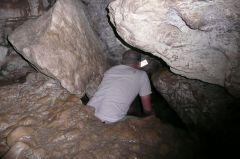
With our internet cravings satisfied in Te Anau, the only plan for the day was just a drive to the south coast. That was until we spotted some DIY (i.e. free!) caving at Clifden. Now we’ve been in quite a few caves on our travels now, so didn’t expect to be surprised by what we found. What did surprise was where they expected us to go. Helpful reflective strips marked the path, which was great until it reached a point where the roof had caved in, and they expected you to clamber between the rocks. I’m not a claustrophobic person, but there was no way I could (or would) squeeze myself through those cracks!
Milford Sound
The road to Milford Sound is a bit like the Great Ocean Road, funded by the government during the depression, and essentially just a nice road to drive along. The main feature of the road is the Homer tunnel, hand-carved through what looked like a lot of very hard rock, and at a steep decline that runs for about 1km in the dark. On our way out we saw some crazy cyclists about to cycle up it, not my idea of fun! (Dad, did you do that?!)
The Milford sound, or more accurately Milford Fiord can only really be seen by boat, and from the plethora of tours, we chose the one that went the furthest and had free soup. As soon as we left port, the Mitre Peak dominated the skyline, all 6000+ft (that’s 1.5 Ben Nevis’) of it that rises nigh on vertically from the sea. Heading out to sea, the hills were lower and rounder as we had passed over the fault line between the Pacific and Australian tectonic plates (could be wrong there…), with the sharp tall peaks on one plate, and the lower hills on another – geology in action! The whole of New Zealand is geologically new and has loads of earthquakes – can’t wait to experience one, as long as it’s not too big!
One last scare…
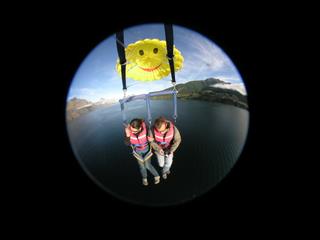
Thinking we’d make our last ride before leaving Queenstown a gentle one, we chose a paraflight, where a parachute is towed behind a boat for great views over the lake. We were strapped into harnesses one more time, and winched out the back of the boat, and up to about 100 metres high. I thought this was all very nice, a bit chilly but nice views over the early morning clouds, whereas Caroline wasn’t too sure about the whole thing. Then we started to fall, and fall, until we were a few metres from the lake. That’s about the time I seriously considered that there was something wrong with the boat, and made plans for getting wet. At the last moment we were tugged up high again, in another example of the Kiwi sense of humour. Still it got the adrenalin pumping, and it wasn’t even 10am!
With that in mind, we high-tailed it out of Queenstown, to save our hearts and wallets from all the excitement. The sun beat down as we drove through to Te Anau, and started up the Milford Road, the easy option to get to the Milford Sound, compared to the Milford Track!
Crazy Town – Part II: Floating
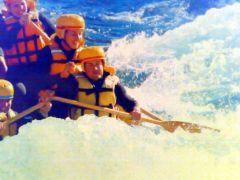
As if jumping off a big cliff wasn’t enough excitement for one day, in the afternoon we slipped/squeezed into wet suits one more time and made for the rapids of the Kawarua river. With five rafts to choose from, we wimped out and opted for the “dry boat”, as in they promised not to turn the thing over on purpose. The first section was quite gentle, the clear fast moving river slopped over a couple of rapids and gave us a little bump, but nothing too bad, we even had time to have a swim in the river. Then the real rapids came. With our guide ‘The Chief’ screaming for us to paddle, the raft headed for the huge wave in the middle of the rapids, a few bumps later and I’d left my seat, fortunately not as much as the woman behind who’d left the raft. We tried to pick her up, but the currents were too strong and so left her to climb onto another raft. More rapids were around the corner, with waves coming into the boat there was nothing to do but focus on paddling, and enjoy the splashes! It was knarly!
Queenstown Crazytown – Part I: Falling
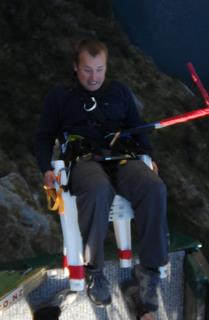
They say that with age comes experience and self knowledge. Well it may have taken me awhile but I have finally learned something about myself. Over the years and in the last few weeks particularly I have found myself in various adrenalin fueled situations that involve some crazy act of leaping / jumping / being pushed from some great height. I keep signing myself up for them and then struggling with the actual leaping / jumping thing. Turns out that at that crucial last second some subconscious part of my brain kicks in and says ‘Are you crazy, you can’t jump off of this perfectly good / safe bridge, platform etc!’. This has been the case with the bungy jump (I was only 17!), the Supaman comet line and just jumping from a rock into a rubber ring in the water.
So it was with this newfound (at long last) self knowledge that I chose my method of swing for the Shotover Canyon Swing (think bungy but without the pinging up bit!). There were ten styles to chose from but the ‘Cutaway’ was only one pant on the pant scale of scariness and best of all it didn’t involve me having to propell myself off the ledge. I would be placed in a harness and sit in a swing like position and someone would then push the button that would make me go. Too easy!? How wrong can you be. It may only be a one panter but it was an adventure too far for me. Of course the crazy Kiwis running the show were a bunch of jokers and seemed to take far too much pleasure in scaring me even more than I already was. They pushed me off the ledge, left me dangling there for a while and then dropped me unexpectedly mid-sentence. It was 109m high with 60m of freefall which trust me is a long time when you are plummeting towards the rocks at the bottom of the canyon. There was a brief moment at the bottom when I braved an eye opening to experience the fun of swinging at the bottom (why we chose this and not one of the five available bungies) and then I was hoisted up and the whole thing was thankfully over. Or so I thought.
I actually found it more traumatic watching Si and Cat do their jumps than I did doing it myself, especially since both of them did it Pin Drop style (a whopping 5 pants on the pantometer!) which involved them stepping of the ledge of their own free will. Crazy dudes. Si (a.k.a Slyman) then continued to age me even further by doing a second jump, this time in ‘the chair’ (a mere three panter!). For this he was tied to a garden chair which he then swung backwards of the ledge to back flip his way to the bottom.
Several hours later the whole ordeal was over and could be forgotten about. Oh, if only it were that easy. The constant reliving it will give me nightmares for days and as for the dvds… (You can check them out for yourselves on the links to the right, look out for Si’s legs in the Pin Drop and the expression on his face as his chair leans back that final time, which is also on the blog photo) I have to point out that in Cat’s dvd that is my scream that can be heard, she was as cool as a cucumber!
Queenstown, here we come
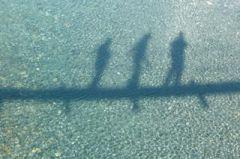
Saving some money as well as getting back to nature, and our first Department of Conservation (DoC) campsite night was a success, but with the luxury of flushing loos and a shower in the van, it wasn’t really roughing it. Driving through the Southern Alps on the Haast pass was a treat for the eyes when they weren’t on the road, with huge mountains on each side and ice (or possibly glacier!) topped to boot.
The Kiwis proved a match for the Aussies naming skills with the Blue Pools, ice cold, clear and blue, and a wobbly swing bridge on the way too. The scenery continued to amaze for the rest of the drive to Queenstown, and it’s easy to see why the area is home to loads of the Lord of the Rings film sets. Queenstown is also activity central, so as a warm up we booked on to a paraflight, a parachute towed behind a boat, but alas the wind again put the stops on us, so there’s only one thing to do – wait until tomorrow…